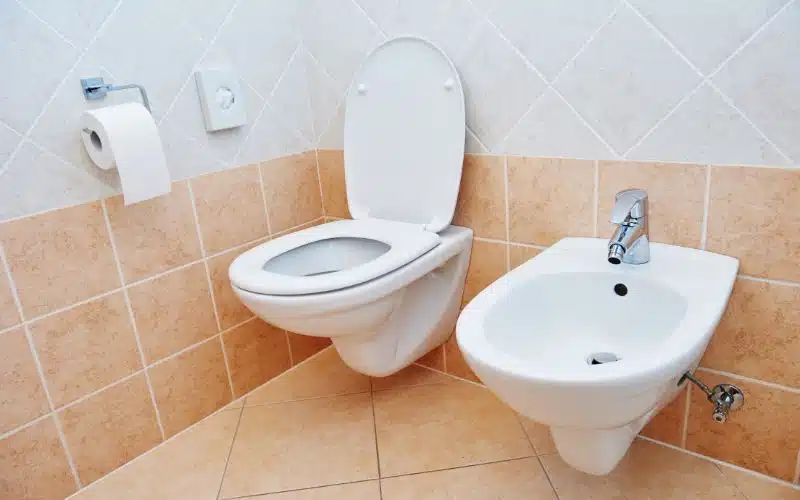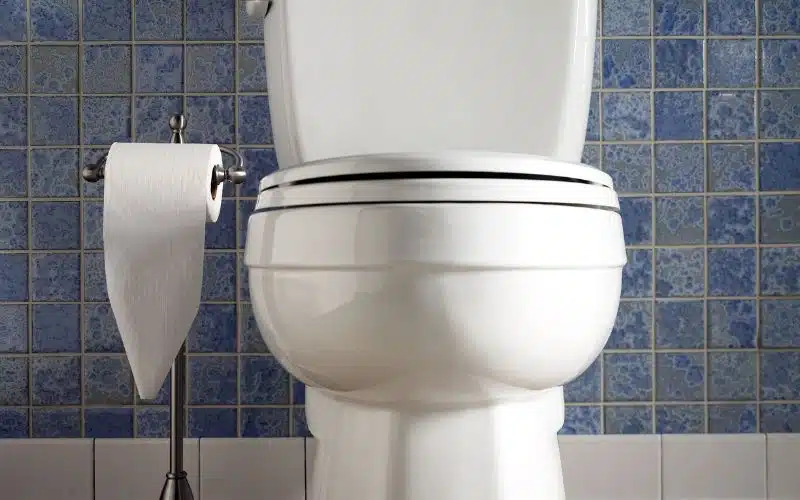A host of factors cause wobbly toilet seats. This issue is very annoying and can lead to hazards when not taken care of immediately.
The problem may seem like a tightening issue with the nuts on the underside of your toilet.
However, some toilets do not have nuts on their undersides. It, however, does not mean the problem is without a solution. This article explains why your toilet seat always loosens and how to fix it.
The screws on the underside of your toilet may be loose and need tightening. The problem might be an improperly installed mounting base or the screws being too small for the bolts to hold the toilet seat in place effectively. If your toilet doesn’t have underside nuts, search the seat hinges for a lid that will reveal the concealed screws.
Why Is My Toilet Seat Always Loosened?

It is mainly due to slacking in the bolts and nuts of the toilet seat. To fix it, tighten the screws with a screwdriver.
There are other reasons why your toilet seat may loosen. One is an improperly installed mounting base. The mountain base is the support used to attach the seat to the bowl.
If the mountain base is not installed properly, it will wobble and affect the bolts and nuts attached to the toilet seat. Causing the screws to slack or pull out from their holes entirely.
A professional installing your toilet mountain base is key to preventing this issue. Also, inspect the installation to make sure it is well installed.
There is, however, an allowable distance your toilet seat can safely move that should not cause any harm to the bolts and nuts attached to the toilet seat.
This distance is about ¼ inch at the front of the toilet bowl before returning to its original position.
Any movement that encroaches further than this length can be a problem, and you may need to replace your toilet seat.
However, if the wobble is within the normal range, be rest assured there is nothing wrong with your toilet seat.
If the slight wobble makes you uncomfortable, you can apply a small amount of Plumber’s Teflon tape to the edges to hold the toilet seat tight.
Another reason your toilet seat always loosens is that the screws and bolts may not fit correctly. It is usually the fault of the manufacturer.
You can buy a new set of plastic bolts and nuts to replace the old one. Ensure they fit correctly before installing and tightening them to the toilet seat.
If you notice that your nuts fit perfectly into the bolts; however, they can’t seem to tighten, the issue is that the rubber fixings are most likely warped.
This problem is fairly common, and you would only need to buy and install a new one. Below is a table of a few quality rubber fixings you can try.
| Rubber Fixings | Features |
|---|---|
| 6 Pack Universal Toilet Seat Expanding Rubber fixings. | Expensive, durable, and rarely warps. |
| iFealClear Universal Toilet Seat Rubber fixings. | Durable, expensive, and comes in various colors. |
| Universal White Plastic Toilet Seat And Bolt Screw | Cheap, made of plastic, rarely warps. |
How Do I Tighten My Toilet Seat?
To tighten your toilet seat, you will need a few tools. They include the following;
- A Screwdriver
- A Plier or a Ratchet Wrench (Optional)
- Hacksaw blade (Optional)
The procedure to tighten your toilet seat is very simple. The step-by-step guide is listed below.
#1. Locate the Bolts
Some toilet seats do not have exposed bolts where the nuts are screwed. Most toilet brands conceal the screws from being visible to add to the aesthetics of their toilet systems.
It doesn’t mean they do not come with screws or the toilet seats are not held in place with bolts and nuts.
They are, but you need to search for a lid button that unlocks the cavity where the screws are.
Some toilet systems screw directly to the wall, so you must change and tighten the screws from the wall.
#2. Begin Tightening
Slot the nuts into the bolts and tighten them with a screwdriver. If the bolts have slotted heads, tighten them in the clockwise direction.
Do the same on each side of the toilet seat. If you experience difficulty tightening the nuts, use the plier to hold the bolt steady while you screw in the nuts with the screwdriver from above.
Some toilets use plastic screws. Use gentle force when tightening plastic screws. In all, ensure not to overtighten the screws. It can lead to cracks in the toilet.
#3. Replace Bolts If Worn Out
If you tighten your toilet screws regularly, there is a chance the bolts may wear out. Tightening won’t work on worn-out bolts.
It would be best if you replaced the bolts and nuts to tighten the toilet seat effectively. The essence of the hacksaw blade is to cut off bolts frozen to their hinges.
The blade will free the bolts without cracking the toilet. Below is a table of useful products that can assist you in tightening your toilet seat:
| Products | Features |
|---|---|
| Bornfel Toilet Lid Screws | Thick, strong, durable metal washers. |
| Ginsey Toilet Seat Tightening Kit | Strong, extremely durable, and contains three sets of washers that fit most toilet seats. |
How Do You Fix a Toilet Seat That Won’t Tighten?
In cases like these, it is best to replace the bolts and nuts with a new one entirely.
You could also try clamping the bolt underneath with a ratchet wrench and screwing in the nut from the top. Ensure you are tightening the nut in the correct direction (clockwise).
However, the bolt thread is worn or damaged when your toilet seat doesn’t tighten, even after using a clamp to steady the bolt.
Sometimes changing the bolts and nuts will not solve the issue if the seat is in bad shape.
Therefore, you should consider changing toilet seats when replacing bolts and nuts. Do this only if the toilet seat is in poor shape.
Even after changing bolts and nuts or tightening screws, the toilet seat may still be shaky. It’s natural for almost all toilet seats after tightening.
The essence is to give the bolts room for flexibility, so they don’t buck up or freeze during winter.
Also, if the bolts and nuts are too rigid, they may crack or break easily. However, this is still an issue for most people.
To solve it, decouple the bolts and nuts and fix them in plastic or rubber washers before screwing them back together.
The washers will provide extra grip and tightening while giving the joints room for enough flexibility. When buying a new toilet seat, there are a few things you should put into consideration.
- Opt for a toilet seat made by the same manufacturers as your previous one. Do this only if you are satisfied with the quality of the previous one. Replacing your toilet seat with a different brand may put you at a disadvantage. The toilet seat may not fit properly. Therefore, buying a toilet seat that is the same brand as your toilet system is best.
- Opt for plastic toilet seats; they are easier to clean and won’t cause a hassle when installing. Also, save the nuts from the old toilet seat. You may need them some other time.
How Can I Stop My Toilet Seat From Moving?
You can use a toilet seat tightening kit or toilet seat stabilizers to solve this problem.
However, toilet seat tightening kits are preferable because they are cheaper and more effective. Tightening kits contain six rubber washers, enough for three toilets.
Below are the steps for installing the toilet seat tightening kit.
#1. Step 1:
Remove the kit from its wrap.
#2. Step 2:
Unscrew the nuts attached to the toilet seat with a screwdriver.
#3. Step 3:
Attach the washer from the tightening kit to the screw through the bottom.
#4. Step 4:
Screw back the nut in place. Ensure it laps well with the washer.
#5. Step 5:
Tighten the bolt and nut very well. If you have difficulty doing so, use a ratchet wrench to grip the bolt from the bottom while you screw in the nut with a screwdriver. You can also use a coin in place of a screwdriver.
#6. Step 6:
Do the same thing for the other side of the toilet seat.
#7. Step 7:
The washer adds more grip to the bolt and nuts, holding your toilet seat in place. It, in turn, prevents the seat from wobbling excessively.
How Do Seat Stabilizers Work?
Toilet seat stabilizers prevent toilet seats from sliding out of place. Once secured tightly, they keep the toilet seat in place and relieve wear and tear on the hinges.
Each toilet seat stabilizer set contains two right-angle bumpers, four screws, and two rubber bands (for positioning before screwing in the nuts).
Ensure to fix the rubber bands properly before screwing the nuts in. Seat stabilizers work similarly to tightening kits.
However, seat stabilizers feature peg-like hooks that firmly hold the toilet seat compared to tightening kits attached to the screws holding the toilet seat.
Toilet Seat stabilizers attach underneath the toilet seat cover. They are plastic; hence they can break easily.
The screws on toilet seat stabilizers are prone to rust. Always change them at least once a year.
Conclusion
The main cause of loose toilet seats is slacking from the bolts and nuts holding the seat in place.
Tightening the screws will solve this issue. In cases where the bolts wear out or the rubber fixings warp, replace them entirely.
Toilet seat tightening kits and seat stabilizers provide a strong grip on toilet seats, preventing them from wobbling.





